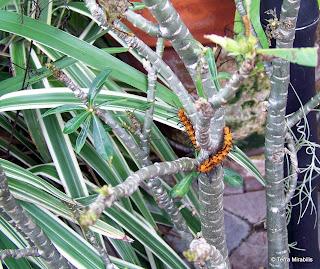 |
| Credit: Wikipedia, Bugboy52.40 |
It's odd how attitudes will change. I spend a lot of time in the garden encouraging butterflies to visit and to lay eggs, but when an unwanted one arrives, I'm furious!
In this case, it's the oleander -- or polka dot -- moth
(Syntomeida epilais) that's got my dander up. How dare it (they) lay eggs all over my Adeniums!
The harmless caterpillar looks a lot like that of the gulf fritillary, and the moth itself, which is actually rather beautiful, gets its name because, well, it likes oleanders. I no longer have oleanders, which are in the
Apocynaceae family, along with Adeniums and my
Mandevilla splendens that the caterpillars have also eaten back to the stems.

Since I do my best to stick to a no-kill policy, and because I do encourage wildlife to visit, this presents a dilemma, especially with at least eight much prized desert rose plants.
So, early in the week I went to a fabric shop and bought several yards of white nylon netting, the kind of material used for the underskirt of a wedding gown. The photo illustrates the first attempt of wrapping up a plant after picking off any caterpillars.
Fingers crossed this will do the trick. Stay tuned.

















